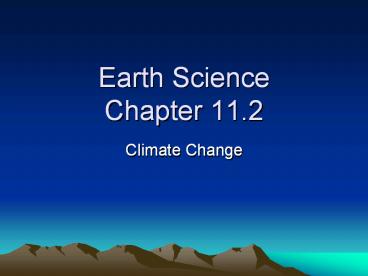Earth Science Chapter 11.2 - PowerPoint PPT Presentation
1 / 17
Title: Earth Science Chapter 11.2
1
Earth ScienceChapter 11.2
- Climate Change
2
Climate Change
- Climate change ? the change in long-term weather
patterns in certain regions. - Global warming refers to a world-wide increase
in average temperature, but is only one aspect of
climate change. - Several ice ages have occurred in the past
million years. - Both the causes and effects of global warming are
unknown and controversial.
3
Greenhouse Effect
- As greenhouse gases (e.g. CO2) increase, they
absorb more heat reflected back from the earth,
warming the atmosphere. - Human activities increase some greenhouse gases.
- Greenhouse gases include water vapour, CO2, N2O,
CH4, and CFCs.
4
Carbon Dioxide
- CO2 levels have increased greatly in the past 200
years. - Since the Industrial Revolution, humans have
greatly increased their overall use of fossil
fuels, which release CO2 when burned. - Deforestation has changed carbon sinks, such as
forests, into carbon sources. - Many people are attempting to reduce CO2
emissions by using alternative energy sources or
by reducing their energy use. - Carbon offsets, such as wind farms, can be
purchased - to offset CO2 emissions.
5
Methane
- Methane is very efficient at trapping thermal
energy. - 25X more efficient than CO2
- Methane is produced by bacteria breaking down
wastes in - oxygen-free environments, animals digesting
- plant matter, rice paddies (and other natural
wetlands), - and the burning of fossil fuels.
6
Nitrous Oxide and Ozone
- Nitrous oxide, N2O, is the third largest
contributor to the greenhouse effect. - Even though there are only small amounts, it has
300X more global warming potential than CO2. - N2O comes from bacteria, fertilizers, and
improper disposal of human and animal waste.
- Ozone is an important UV radiation blocker in the
stratosphere. - At lower altitudes, however, it is a very
powerful greenhouse gas. - This ozone comes from solar radiation reacting
with pollution from the burning of fossil fuels,
and is released from photocopiers and certain air
conditioners.
7
CFCs (Chlorofluorocarbons)
- Halocarbons, used as refrigerants, are strong
greenhouse gases. - Chlorofluorocarbons (CFCs) are the best-known
halocarbons. - Halocarbons ? ozone layer depletion.
- Cooling Units Use CFCs Some Aerosols Use CFCs
8
Albedo and Climate
- The albedo at Earths surface affects the amount
of solar radiation that region receives. - Changes in a regions albedo - for example, snow
cover melting earlier in the season than it did
previously - Could result in climate change. - Forests have a low albedo. Deforestation
increases albedo. - Forests also emit large amounts of water vapour,
which reflects solar radiation back into space. - Deforestations effects on climate change are
unknown.
9
Role of Science
- Computer models of Earths climate.
- Most show that a decrease in the production of
greenhouse gases is necessary to stop the
apparent global warming trend. - General Circulation Models (GCMs) use data from
multiple locations over long periods of time. - Can look at changes in greenhouse
- gases, albedo, ocean currents, winds
- and surface temperatures.
- Can forecast weather, analyse climate
- and make predictions.
- Use past information to predict
- future conditions.
10
International Cooperation
- The United Nations World Meteorological
Organization ? Intergovernmental Panel on Climate
Change (IPCC) to address global concerns about
climate change and global warming (formed in 1988
with 130 countries) - The IPCC examines possible
- climate change, highlights the
- causes, and suggests solutions.
- Treaties to reduce greenhouse
- gas production are voluntary,
- which means some countries
- dont honour their pledge.
11
Global Impacts of Climate Change
12
Impact of Climate Change on
- Temperatures are increasing (average increase
0.5ºC to 1.5ºC). - Arctic regions are losing permafrost and ice
cover on oceans. - Growing seasons are getting longer and more
precipitation is falling in the spring (possible
drought in later summer). - Rise in sea levels.
- Glaciers are melting (less drinking water).
- Fisheries could be very negatively affected.
- Pollution ? health issues.
13
Temperature Change Predictions for Canada
14
Climate Change in B.C.
15
Climate Change in B.C.
16
Strategies for Addressing Climate Change
- Although climate change is a controversial issue,
our actions now are important. - Improving our environmental approach will help,
no matter how dramatic climate change actually
is. - Not acting could result in huge problems.
- The United Nations suggests the precautionary
principle, better safe than sorry. - Relatively small changes could have large
positive impact on the climate in Canada. - Reduce vehicle greenhouse gas emissions.
- Reduce industrial greenhouse gas emissions.
- Increase use of energy-efficient products.
- Improve indoor air quality.
17
(No Transcript)































